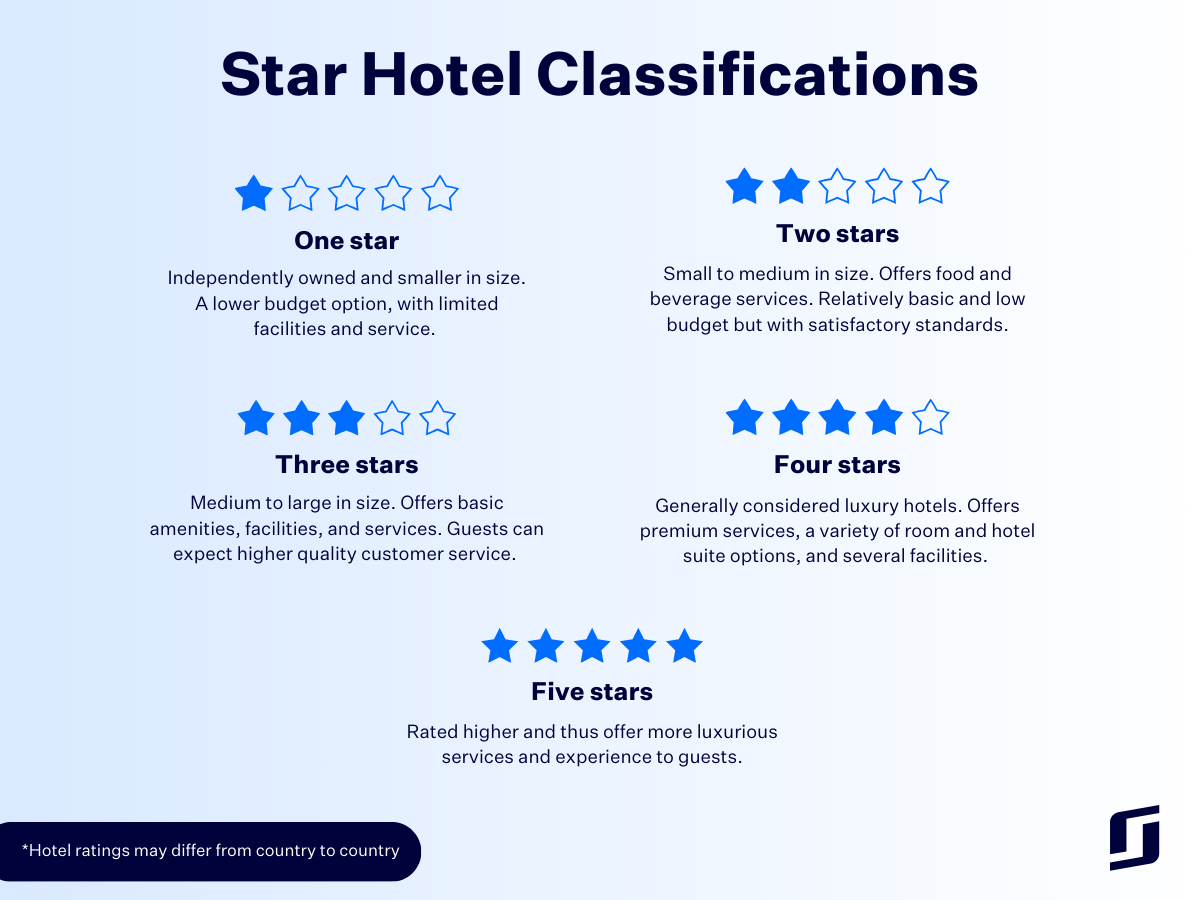What is a hotel classification?
A hotel classification is a way for guests to understand the quality and style of the hotel they are booking. Hotels are often classified based on various criteria such as star rating, ownership or management, guest type, and length of stay, among others.
Hotel classifications immediately let guests know what kind of service and amenities they can expect. This also helps hotels market their offerings and also makes it easier for travellers to research and book accommodation.
But there are many different ways to classify hotels, including being based on who owns them or the guests they attract.
So with that in mind, let’s take a look at all the different hotel properties and classifications.
Table of contents
Why is hotel classification important?
Hotel classification is important because it helps guests set expectations for their experience, enables easy hotel comparisons for informed booking decisions, and allows travellers to find accommodations that match their preferences and budget. For the industry, classification systems establish quality standards for properties to maintain, provide hotels with effective marketing angles, and build guest trust through transparent service level indicators. This standardization benefits both guests seeking appropriate accommodations and hotels positioning themselves in competitive markets.
Here’s how hotel classification helps both guests and hotel owners:
For guests:
- It helps set expectations for what their experience will be.
- It enables them to compare hotels easily and make an informed booking decision.
- It allows them to find the right fit for their preferences.
For the industry:
- It helps to set standards of quality for properties to adhere to.
- It gives hotels another marketing angle.
- It builds trust with guests.
Of course, there are always variations and tangible differences even in hotels that are classified as being the same. Guests also differ in their standards and expectations, but classification remains an important and useful guide for everyone.
Classify your hotel as profitable
What if you could easily boost your hotel's revenue and become more efficient? Our smart hotel platform helps you do exactly that.
Learn more
What is a hotel classification system?
A hotel classification system is an organised structure that helps governing bodies determine the category of a specific hotel. The hotel classification system that most of us are probably keenly familiar with is the system that ranges from one star to five stars.
Each star rating is linked to a set of criteria that considers factors like room size, amenities offered, guest services, and sometimes even food and beverage options.
This is the most common classification of accommodation worldwide. However, it’s important to note that there is no one global governing body for hotel star ratings. In fact, most organisations that provide star ratings in each country are independent agencies and not government authorities.
Some of the most prominent organisations that determine hotel star ratings include:
Australia – Quality Tourism Australia
USA – American Automobile Association
Europe – HotelStarts Union
United Kingdom – AA Hotel and Hospitality Services
The UN World Tourism Organisation also works to improve tourism competitiveness, promote sustainability and regulate standards.
There are plenty of other agencies that are responsible for hotel classifications in their respective countries and regions, and they all have slightly different guidelines that affect a hotel’s star rating. That being said, they all follow a similar system, with one star being the most basic accommodation and five star being on the luxury end of the scale.

What are the different hotel star classifications?
Hotel star classifications range from one star (basic accommodations with minimal amenities and sometimes shared bathrooms) to five stars (luxury properties with premium services like concierge, valet parking, 24-hour room service, and extensive facilities). Two and three-star hotels offer mid-range options with en-suite bathrooms and standard amenities, while four-star properties provide premium services with multiple facilities like spas, pools, and business centers. While some hotels market themselves as “seven star” for luxury positioning, official rating systems typically max out at five stars.
Let’s discuss the star classifications in greater detail:
One star hotel classification
The most basic standard of accommodation, usually independently owned and smaller in size. Room prices reflect the limited quality and range of services available. As a low budget option, there are usually no additional facilities and no room service. Certain rooms may not have en-suite bathrooms, requiring shared toilet and shower facilities.
Two star hotel classification
These hotels usually come with en-suite bathrooms and are normally small to medium-sized properties offering some food and beverage services.. Still relatively basic and low budget but with slightly higher standards and services than one-star properties.
Three star hotel classification
Offer more services and facilities as a middle-of-the-road option, providing all basic amenities and services expected from a hotel without extra luxury features. Criteria may differ by country, but generally include variety in room categories, on-site facilities like gyms and restaurants, and some room service. Guests expect high quality customer service at this level.
Four star hotel classification
Although not quite as luxurious as 5-star hotels, guests pay for premium service. Requirements vary by regulatory agency, but typically include variety in room and suite options, 24-hour room service, and numerous facilities such as swimming pools, spas, gyms, restaurants, meeting rooms, business centers, and secure parking. They are generally considered luxury hotels.
Five star hotel classification
Five-star hotels offer luxury service to their guests. To achieve a rating higher than four stars, they must provide elevated service levels and premium amenities throughout the property.
Services and features you can expect at five-star hotels include:
- Concierge and reservations desk
- Valet parking
- 24-hour room service
- A doorman or butler
- Nightly turndown services
- Laundry services
- Shoe polishing services
- Dry cleaning and ironing services
- In-house fine dining establishments (usually multiple bars and restaurants)
- Transfer services
- In-house childcare services
- Flat-screen smart TV with international programming and streaming services
- Fully stocked mini bar and fridge
- An array of spa facilities and treatments
- Luxury bedding
- Luxury en suite with multiple shower jet options
- Swimming pools
- Gym facilities
- Sauna
Not every five star hotel will have all of these features, however they will all offer a high level of service and go the extra mile to provide a luxurious experience.
Seven star hotel classification
There isn’t a universally recognized 7-star rating, despite popular belief. It’s an unofficial term coined by a journalist for the Burj Al Arab in Dubai to emphasize its luxury level. Some luxury hotels use seven-star terminology for marketing purposes, but officially, hotel rating systems max out at five stars.
Read our full guide on star ratings to learn how they are determined and how you can improve yours.
Maximise direct bookings from your website
SiteMinder integrates with leading hotel booking engines to keep your rates and inventory up-to-date in real-time, delivering commission-free direct bookings straight to your PMS.
Learn More
What are the hotel classification guidelines?
Hotel classification guidelines generally involve specific quality standards around hotel rooms, amenities, and more. They can differ from country to country and depend on different governing bodies.
Though there is typically some common ground that makes it easier to identify how a hotel might be correctly classified. Key factors include:
- Rooms: Hotels with bigger rooms and rooms that have more features are more likely to get a higher star rating than those with smaller rooms.
- Amenities: More amenities and higher quality amenities will boost a hotel’s appeal and rating.
- Food and beverage: Does the hotel have its own restaurant, room service, and additional bars or cafes?
- Accessibility and convenience: The hotel may be rated higher if it’s in close proximity to major attractions and transport.
- Staff: The level of professionalism and personalisation from staff plays an important role in classifying a hotel.
Other considerations such as the level of safety and security, cleanliness, and sustainability could come into play as well.
What are the different types of hotel classifications?
Hotels can be classified in multiple ways beyond star ratings: by location (city/business, suburban, rural, airport, resorts, B&Bs), by size (small 0-25 rooms, medium 26-300 rooms, large 300+ rooms), by guest type (tourists, business travellers, families, delegates), by length of stay (transient, semi-resident, extended stay), and by ownership structure (independent, management contract, franchise/chain, timeshare, condominium). Each classification method serves different purposes for guests seeking specific accommodation types and helps hotels position themselves in appropriate market segments.
Let’s explore these alternate classifications in greater detail:
Hotel classification by location
Guests can also form expectations based on where a hotel is located. Certain destinations typically include accommodations that have specific characteristics. Here are some of the most common examples:
City/Business hotels
While anyone can use this accommodation type, these establishments primarily target business travellers.
Priority services and facilities in these kinds of hotels will therefore include:
- Conference rooms
- Video conferencing capabilities
- High speed internet access
- Workspaces within the rooms
- Communal work spaces or business centre
- Executive suites
- Access to transport
Suburban Hotels
Located on the outskirts of major cities, these hotels cater to both business and leisure travellers. They often offer lower rates than city center properties and typically include amenities like pools or on-site restaurants.
Rural Hotels
Found in countryside locations or near natural attractions, these hotels cater to leisure travellers seeking relaxation or outdoor activities. They might be smaller properties with a focus on nature and include amenities like spas or eco-friendly practices.
Airport hotels
Located near airports, these hotels serve travellers with long layovers, missed flights, or late arrivals. They’re primarily used for short stays, creating high turnover rates. While typically used for one night or even a few hours, airport hotels vary in service levels and star ratings. Since proximity to the airport is the main factor for guests, many large hotels offer various service levels within one building. The same hotel might provide five-star suites alongside basic budget options.
Resorts
Typically all-inclusive experiences, resorts are often located in beautiful and/or remote locations such as coastal landscapes, tropical forests, or in adventure destinations such as snow fields.
B&B/Homestays
With guests sharing a residence with the owner or manager, Bed & Breakfasts and Homestays are often small, family run businesses. The level of service in these kinds of establishments can vary significantly as can the price tag.
These establishments are commonly found in small towns or rural areas. Guests often choose them for local insights, making friendly, hands-on service essential to successful B&B operations.
Green/sustainable hotels
Sustainable or Eco-friendly hotels are establishments that are built and / or operated in ways that minimise the hotel’s carbon footprint. From using only local produce and products to creating energy saving and water saving systems, there are many ways hotels can be sustainable. These establishments are most often located in regional or rural areas that are rich in natural resources.
Roadside hotels
These accommodations are situated alongside major roads and highways, positioned for ultimate convenience for road-tripping travellers. They provide simple comfort and essential amenities.
Hotel classification by size
Classification of hotels based on size isn’t a reflection on the quality and service level. Instead, it categorises hotels based solely on the amount of rooms available.
Much like star ratings, this system can vary depending on the region and style of hotel in question. For example, a large hotel in a small town in rural Australia could be significantly different to a large hotel in New York City.
Equally, a boutique hotel with 25 rooms might be considered large but a chain hotel with 25 rooms would be considered small. Broadly speaking, however, hotel sizes can be grouped in the following categories.
Small
Any establishment with 0 – 25 guest rooms can be considered a small hotel.
As you may recall from earlier in this article, one star hotels usually fit into the ‘small’ category. However, you could equally have a luxury boutique hotel that is technically considered small in size.
Medium
Anything between 26 and 300 guest rooms can be considered a medium size hotel.
Large
Anything above 300 guest rooms is considered a large hotel.
Hotel classification by guests
Although many hotels will try to service a broad range of guests in order to maximise profits, the best hotels understand their main target demographic and tailor their services to cater for them. Different traveller segments will require different accommodations in a hotel.
There are many different types of guests, and some travellers might fall into multiple categories. However, here are some of the main categories of guests that require different rooms in a hotel.
Tourists
Tourists come in all shapes and sizes. Some want clean, quiet accommodations in city centers, while others rely heavily on concierge services and facilities like spas and restaurants.
Business
Business travellers also have a variety of needs. Some might require executive suites whereas others just want a room with a desk space and high speed internet.
Families
Family preferences range from all-inclusive resort experiences to safe, comfortable budget accommodations.
Travellers/Nomads
Backpackers and travellers generally don’t require luxuries or lavish services; often prioritizing social and communal spaces over large or luxurious bedrooms.
Delegates
Delegates are usually in the area for a conference or event. Some may just want a quiet and clean place to sleep whereas others might require five star treatment.
Stay ahead with realtime pricing intelligence
Get daily pricing recommendations and market alerts delivered to your mobile, so you can instantly capture every revenue opportunity.
Learn more
Length of stay hotel classification
Another Hotel room classification system is by length of stay. Once again, this is not necessarily a reflection on the quality of the hotel but it can inevitably have an impact. For example, hotels where guests are likely to spend a significant amount of time will most likely offer more services and facilities than those who cater to short-stay guests.
Commercial hotels
This term can be confusing as it can also be mistaken to mean a hotel business that is commercial. However, in this context, a commercial hotel refers to one that caters for business travellers.
Although these kinds of guests only tend to stay for a few days, they may expect a certain level of service along with facilities such as business centres, conference rooms and high speed internet connection.
Transient hotels
A transient hotel refers to an establishment where guest stays are generally considered short term (less than 30 days).
Semi-resident hotels
Semi residential hotels are usually priced out on a nightly basis but there is no limit to the amount of time that a guest may book the accommodation. Guests can book semi residential hotel rooms for months or even years at a time but the amount will still be broken down on a daily basis.
Apartment/residential hotels
Residential hotels are usually for longer term stays and can be priced out on a monthly basis. Residential hotels usually have self-sufficient rooms or apartments with kitchen facilities and self-serve laundry options.
Some large companies may even hire out a residential hotel unit for years at a time so that they can provide various employees with accommodation for business travel, pleasure, training and so on.
Extended stay hotels
Extended stay hotels are similar to serviced apartments in that they offer a self-sufficient space for guests to sleep, cook and relax. The difference between extended stay hotels and serviced apartments, however, is that hotels usually offer services like reception, concierge and access to in-house facilities like gyms and swimming pools. Some serviced apartments might offer these too but they are not a requirement.
Classification of hotels on the basis of ownership or management
Another way to distinguish between different kinds of hotels is by the hotel management. These categorisations can be used in conjunction with star ratings or service based classifications.
There are 3 main hotel management categorisations: proprietary ownership, management contract and franchise. However, there are other different categories of hotels to consider such as time-shares and condominiums.
Proprietary ownership
This categorisation of hotels refers to establishments that are independently owned and managed. This kind of hotel business can range from residential facilities to commercial ones. Also known as ‘independent’ or ‘single owner’ hotels, these can often be family run businesses. The standard and size of hotels under proprietary ownership can vary.
Whether it has 50 budget rooms or 1000 luxury suites, it can be included in this category as long as it is independently owned and is not part of a wider company or chain.
Management contract
These hotels are managed by companies or organisations other than the owners. Under this kind of agreement, the owner (or owners) of the hotel will appoint a management company to take over the day to day operations of the hotel, usually on a long term basis.
Franchise/Chains
Franchises and chains are often assumed to be the same thing. Although both can result in the same hotel brand existing across hundreds or thousands of locations, there is a key difference.
Chains are owned and run by corporations. In these instances, the corporation owns the rights to the brand and all services & standards are regulated according to a corporate policy. Franchises on the other hand are operated by individual business owners who have bought the rights to operate under the broader brand name.
Generally, the level of service and aesthetics of a certain hotel brand will be consistent across all locations regardless of whether it’s a chain or a franchise. However, in terms of finance management and operational procedures, a franchisee may pay fees to the corporation in exchange for advertising, reservation systems and other operational necessities.
Time-Share
Broadly speaking, a time-share is a property that is shared by various stakeholders. By buying into a timeshare, you share the cost of the property with others and therefore have guaranteed access to the property for a certain percentage of the year.
In theory, if the timeshare is shared by 12 owners, each owner has access to the timeshare for 1 month of the year. Similarly, if it is shared by 52 owners, each owner will get access 1 week of the year. How and when this access is negotiated depends on the timeshare contract.
There are many different time-share contracts but the two major distinctions are whether they are deeded or leased. Shared deeded contracts means that the owners buy a portion of the property. They therefore share responsibility for maintenance and so on. Shared leased contracts means that you are effectively renting access to the property and the deed remains with the resort or owner.
Condominiums
A condominium is a building which is divided into several units that are separately owned, often with common areas that are jointly owned by owners or residents. A condominium hotel is a building that is legally considered a condominium but is operated as a hotel, providing short term rentals and front desk services.
There are legal complexities as well as advantages and disadvantages to managing or owning a condominium hotel. However, they are generally considered on the luxury side of hotel room categories and can therefore be relatively lucrative.
Hotel room classification comes in many forms. Although the star rating is universally understood by potential guests, there’s no right or wrong way to classify your hotel. The important thing is understanding what your brand is and who it is you are catering for. Once you know that, you can market your hotel with the classification you believe is most suited to your business.


